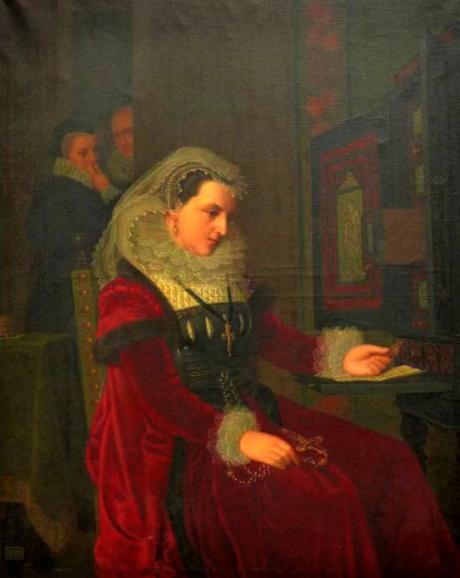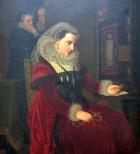This painting illustrates a poignant moment in Scottish history. Mary, Queen of Scots, wearing dark red and black, holding a crucifix and rosary in her lap, and contemplating a miniature of her husband and a completed letter to Henri III of France, brother of her first husband waits for her death warrant.
Mary Queen of Scots was executed at Fotheringhay Castle, Northamptonshire on 8th February 1587. Jane Kennedy, the Queen's attendant, and Elizabeth Curle, a noblewoman, stand in the doorway in grief and anger at the fate of their Queen. The following is an english translation of the letter sent to her late husband's brother Henry III king of France.
"Royal brother, having by God's will, for my sins I think, thrown myself into the power of the Queen my cousin, at whose hands I have suffered much for almost twenty years, I have finally been condemned to death by her and her Estates. I have asked for my papers, which they have taken away, in order that I might make my will, but I have been unable to recover anything of use to me, or even get leave either to make my will freely or to have my body conveyed after my death, as I would wish, to your kingdom where I had the honour to be queen, your sister and old ally.
Tonight, after dinner, I have been advised of my sentence: I am to be executed like a criminal at eight in the morning. I have not had time to give you a full account of everything that has happened, but if you will listen to my doctor and my other unfortunate servants, you will learn the truth, and how, thanks be to God, I scorn death and vow that I meet it innocent of any crime, even if I were their subject. The Catholic faith and the assertion of my God-given right to the English crown are the two issues on which I am condemned, and yet I am not allowed to say that it is for the Catholic religion that I die, but for fear of interference with theirs. The proof of this is that they have taken away my chaplain, and although he is in the building, I have not been able to get permission for him to come and hear my confession and give me the Last Sacrament, while they have been most insistent that I receive the consolation and instruction of their minister, brought here for that purpose. The bearer of this letter and his companions, most of them your subjects, will testify to my conduct at my last hour. It remains for me to beg Your Most Christian Majesty, my brother-in-law and old ally, who have always protested your love for me, to give proof now of your goodness on all these points: firstly by charity, in paying my unfortunate servants the wages due them - this is a burden on my conscience that only you can relieve: further, by having prayers offered to God for a queen who has borne the title Most Christian, and who dies a Catholic, stripped of all her possessions. As for my son, I commend him to you in so far as he deserves, for I cannot answer for him. I have taken the liberty of sending you two precious stones, talismans against illness, trusting that you will enjoy good health and a long and happy life. Accept them from your loving sister-in-law, who, as she dies, bears witness of her warm feeling for you. Again I commend my servants to you. Give instructions, if it please you, that for my soul's sake part of what you owe me should be paid, and that for the sake of Jesus Christ, to whom I shall pray for you tomorrow as I die, I be left enough to found a memorial mass and give the customary alms.
To the most Christian king, my brother and old ally."
Fyfe, William Baxter Collier (c.1836–1882), painter, was born in Dundee and was brought up in the nearby village of Carnoustie. Although discouraged by his family, at the age of fifteen he entered the Royal Scottish Academy, where he was awarded prizes for his crayon portraits. He studied in Paris from 1857 to 1858. His first important picture, Scene in Loch Leven Castle—Queen Mary Compelled by the Nobles to Resign her Crown, was shown at the Royal Scottish Academy in 1861. After spending a year in France, Italy, and Belgium, he settled in London, but passed most of his summers in Scotland.
The Death of John Brown of Priesthill and Jeanie Deans and the Laird o'Dumbiedykes attracted attention, and in 1866 Fyfe began to show at the Royal Academy, exhibiting twenty-six pictures in all, including A Girl of the Period (which became very popular), On Household Cares Intent, and What can a Young Lassie Dae wi' an Auld Man?. Several of his paintings were engraved and appeared in the illustrated newspapers in Europe and the United States, and even Asia. About 1874 he returned to Italy and painted several Italian subjects. His best-known later works included A Good Catholic, Wandering Minstrels, The Love Letter, A Quiet Christmas, The Fisherman's Daughter, and A Chelsea Pensioner. The Raid of Ruthven, his most important historical picture, was exhibited at the Royal Academy in 1878, and afterwards at the Royal Scottish Academy. Among his portraits are those of the earl and countess of Dufferin, Lord Houghton, Peter Lorimer, first principal of the English Presbyterian College, and his friend the artist John Faed. Fyfe died suddenly on 15 September 1882 at his home, 62 Abbey Road, St John's Wood, London, and was buried in Willesden cemetery, London. His son, the architect George Peters Collier Fyfe, survived him.
R. E. Graves, rev. Anne Pimlott Baker DNB
William Baxter Collier Fyfe, (c.1836–1882), painter, was born in Dundee and was brought up in the nearby village of Carnoustie. Although discouraged by his family, at the age of fifteen he entered the Royal Scottish Academy, where he was awarded prizes for his crayon portraits. He studied in Paris from 1857 to 1858. His first important picture, Scene in Loch Leven Castle—Queen Mary Compelled by the Nobles to Resign her Crown, was shown at the Royal Scottish Academy in 1861. After spending a year in France, Italy, and Belgium, he settled in London, but passed most of his summers in Scotland.
The Death of John Brown of Priesthill and Jeanie Deans and the Laird o'Dumbiedykes attracted attention, and in 1866 Fyfe began to show at the Royal Academy, exhibiting twenty-six pictures in all, including A Girl of the Period (which became very popular), On Household Cares Intent, and What can a Young Lassie Dae wi' an Auld Man?. Several of his paintings were engraved and appeared in the illustrated newspapers in Europe and the United States, and even Asia. About 1874 he returned to Italy and painted several Italian subjects. His best-known later works included A Good Catholic, Wandering Minstrels, The Love Letter, A Quiet Christmas, The Fisherman's Daughter, and A Chelsea Pensioner. The Raid of Ruthven, his most important historical picture, was exhibited at the Royal Academy in 1878, and afterwards at the Royal Scottish Academy. Among his portraits are those of the earl and countess of Dufferin, Lord Houghton, Peter Lorimer, first principal of the English Presbyterian College, and his friend the artist John Faed. Fyfe died suddenly on 15 September 1882 at his home, 62 Abbey Road, St John's Wood, London, and was buried in Willesden cemetery, London. His son, the architect George Peters Collier Fyfe, survived him.
R. E. Graves, rev. Anne Pimlott Baker DNB



